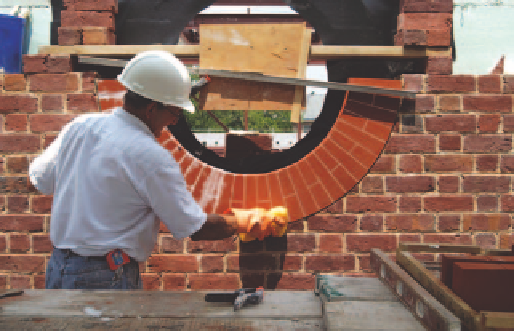Agriculture Reference
In-Depth Information
Figure 163
Chief gauged brick
mason, Ray Cannetti,
constructing the lower
half of a gauged oculus
or bullseye arch on
the South Building,
Colonial Williamsburg,
Virginia. (Courtesy of
Edward Chappell)
Clearly the case for the use of gauged work on a modern construction site hinges
on it being shown to be time and cost effective. Therefore it is essential to carefully
plan the phases of preparatory cutting and rubbing works and the building of
the enrichments, to ensure these neatly dovetail into the overall programme
of work. Despite concerns of costs, the future for this highly-skilled branch
of the craft has great potential providing the investments of time, education, and
finance are put into the aspiring craftsmen bricklayers, the relevant brick compa-
nies, and those responsible for both modern and historic brick-built buildings.
Bricklayers - from Apprenticeships to Training Schemes
The 1914-18 war devastated the flower of time-served bricklayers, men the
craft could ill-afford to lose and who would have passed on the high level
of skills taught to them by their Victorian masters. The Operative Bricklayers
Society (OBS) merged with other craft unions in 1921 to form the Amalgamated
Union of Building Trade Workers (AUBTW), losing a national voice to repre-
sent high-level craft ideals. In 1925 The Interrupted Apprenticeship Scheme was
introduced to help those people whose apprenticeships had been disrupted by
the Great War to resume them and the state became ever more involved in pro-
moting skills establishing Government Training Centres, Instructional Centres
and Junior Instructional Centres. Many conscientious bricklayers, however,
became increasingly concerned for the future of the craft, with its heritage of
skills, knowledge, and standards of excellence founded on a sound time-served
apprenticeship. This was particularly true of brickwork instructors responsible
for theoretical education and refining practical skills of apprentices in new tech-
nology colleges opening in major towns and cities. From the inspiration of E.
Lindsay Brayley, the Guild of Bricklayers was founded in 1932, with the aim of
forming an association of journeymen and apprentice bricklayers, to dissemi-
nate information and skills, and raise standards of craftsmanship and the status

